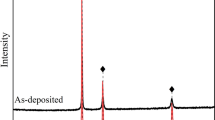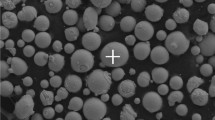Abstract
The advantageous oxidation and wear properties of Cr3C2-NiCr thermal spray coatings have resulted in them being extensively applied to combat erosion at high temperatures. Under these conditions, oxide layers take on an ever more significant role in determining the composite response. The response of blended powder-based carbide coatings for erosion applications has formed the basis for application of cermet-based coatings at elevated temperature. In this study, the oxidation mechanisms of as-sprayed and heat-treated Cr3C2-NiCr blended powder-based coatings are characterized. Interdiffusion between the coating phases with long-term exposure increased the Cr content of the matrix phase. This had a significant effect on the oxidation mechanism. The implications of the change in oxidation mechanism and oxide morphology on the coating response to high-temperature erosion are discussed.







Similar content being viewed by others
References
L.M. Berger, W. Hermel, P. Vuoristo, T. Mantyla, W. Lengauer, and P. Ettmayer, Structure, Properties and Potentials of WC-Co, Cr3C2-NiCr and TiC-Ni Based Hardmetal Like Coatings, Thermal Spray: Practical Solutions for Engineering Problems, C.C. Berndt, Ed., ASM International, Materials Park, OH, 1996, p 89-98
S. Kamal, R. Jayaganthan, and S. Prakash, High Temperature Oxidation Studies of Detonation-Gun-Sprayed Cr3C2-NiCr Coating on Fe- and Ni-Based Superalloys in Air Under Cyclic Oxidation at 900°C, J. Alloys Compd., 2009, 472(1-2), p 378-389
S. Matthews, B. James, and M. Hyland, Erosion of Oxide Scales Formed on Cr3C2-NiCr Thermal Spray Coatings, Corros. Sci., 2008, 50, p 3087-3094
S. Matthews, M. Hyland, and B. James, Microhardness Variation in Relation to Carbide Development in Heat Treated Cr3C2-NiCr Thermal Spray Coatings, Acta Mater., 2003, 51(14), p 4267-4277
S. Matthews, M. Hyland, and B. James, Long-Term Carbide Development in High Velocity Oxygen Fuel/High Velocity Air Fuel Cr3C2-NiCr Coatings Heat Treated at 900°C, J. Therm. Spray Technol., 2004, 13(4), p 526-536
S. Matthews, “Erosion-Corrosion of Cr3C2-NiCr High Velocity Thermal Spray Coatings,” Doctoral Thesis, Department of Chemical and Materials Engineering, The University of Auckland, Auckland, 2004
A. Roine, HSC Chemistry, Outokumpo Research Oy, Finland, 1997
R.Z. Vlasyuk, I.D. Radomysel’skii, V.P. Smirnov, and A.A. Sotnik, Dissolution of Cr3C2 in a Nickel Matrix During Sintering. I: Reaction of Chromium Carbide with Nickel During Solid Phase Sintering, Sov. Powder Metall. Met. Ceram., 1985, 24(4), p 269-273
R.Z. Vlasyuk, I.D. Radomysel’skii, and A.A. Sotnik, Dissolution of Cr3C2 in a Nickel Matrix During Sintering. II: Formation of a Liquid Phase in the Cr3C2-Ni System During Sintering, Sov. Powder Metall. Met. Ceram., 1985, 24(5), p 356-360
T. Taylor, Phase Stability of Chrome-Carbide NiCr Coatings in Low Oxygen Environments, J. Vac. Sci. Technol., 1975, 12(4), p 790-794
S.F. Korablev, A.V. Lysenko, and S.I. Filipchenko, Chemical and Kinetic Peculiarities of the Oxidation of Powdery Chromium Carbide, Sov. Powder Metall. Met. Ceram., 1988, 27(7), p 584-587
S. Loubiere, C. Laurent, J.P. Bonino, and A. Rousset, Elaboration, Microstructure and Reactivity of Cr3C2 Powders of Different Morphology, Mater. Res. Bull., 1995, 30(12), p 1535-1546
N. Birks and G.H. Meier, Introduction to High Temperature Oxidation of Metals, Edward Arnold, London, 1983
P. Moulin, A.M. Huntz, and P. Lacombe, Influence des Phenomenes Diffusionnels sur le Mechanisme D’Oxydation des Alliages Ni-Cr (Influence of Diffusion on the Mechanism of Oxidation of Ni-Cr), Acta Metall., 1980, 28, p 745-756
J.M. Guilemany and J.A. Calero, Structural Characterisation of Chromium Carbide-Nickel Chromium Coatings Obtained by HVOF-Spraying, Thermal Spray: A United Forum for Scientific and Technological Advances, C.C. Berndt, Ed., ASM International, Materials Park, OH, 1997, p 717-721
Acknowledgments
The authors gratefully acknowledge the assistance of WOKA GmbH, Metal Spray Suppliers (NZ) Ltd, and Holster Engineering (NZ) Ltd for supplying the powder and coatings for this work. The financial assistance provided by Material Performance Technologies (NZ) and The University of Auckland is greatly appreciated.
Author information
Authors and Affiliations
Corresponding author
Additional information
This article is an invited paper selected from presentations at the 2009 International Thermal Spray Conference and has been expanded from the original presentation. It is simultaneously published in Expanding Thermal Spray Performance to New Markets and Applications: Proceedings of the 2009 International Thermal Spray Conference, Las Vegas, Nevada, USA, May 4-7, 2009, Basil R. Marple, Margaret M. Hyland, Yuk-Chiu Lau, Chang-Jiu Li, Rogerio S. Lima, and Ghislain Montavon, Ed., ASM International, Materials Park, OH, 2009.
Rights and permissions
About this article
Cite this article
Matthews, S., James, B. & Hyland, M. The Effect of Heat Treatment on the Oxidation Mechanism of Blended Powder Cr3C2-NiCr Coatings. J Therm Spray Tech 19, 119–127 (2010). https://doi.org/10.1007/s11666-009-9381-7
Received:
Revised:
Accepted:
Published:
Issue Date:
DOI: https://doi.org/10.1007/s11666-009-9381-7




